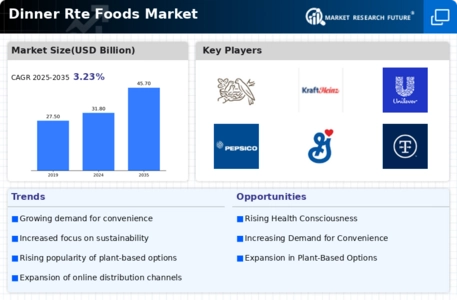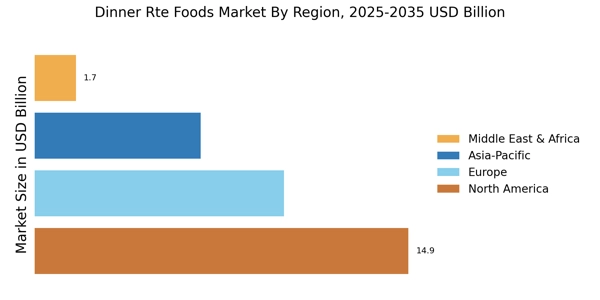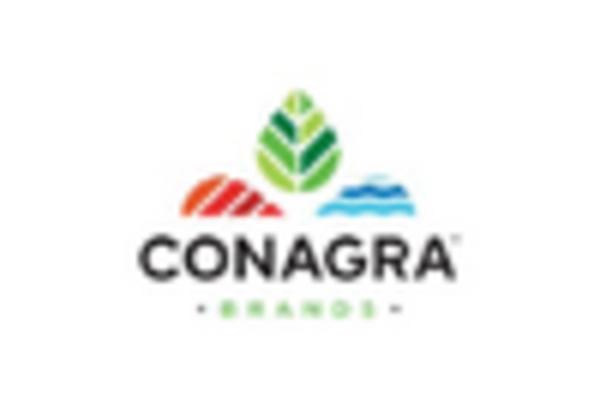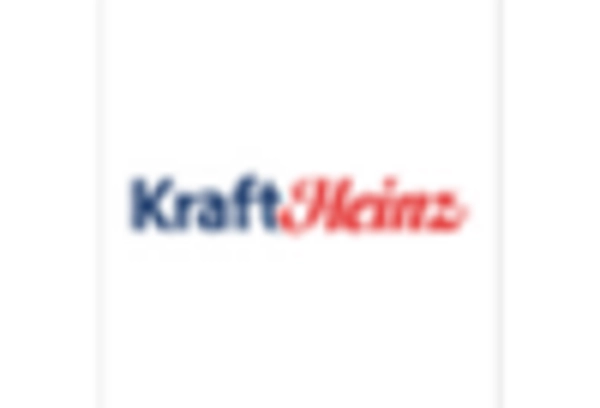Health and Wellness Trends
In recent years, there has been a notable shift towards health and wellness within the Dinner Rte Foods Market Industry. Consumers are increasingly prioritizing nutritious options that align with their dietary preferences, such as low-calorie, organic, and gluten-free meals. This trend is supported by data indicating that nearly 60% of consumers are willing to pay a premium for healthier meal options. As a result, manufacturers are reformulating their products to include wholesome ingredients and transparent labeling. The Dinner Rte Foods Market Industry is responding to this demand by expanding its offerings to include meals that cater to specific dietary needs, thereby attracting a broader customer base. This focus on health is expected to drive innovation and growth within the sector.
Changing Consumer Preferences
The Dinner Rte Foods Market Industry is currently influenced by shifting consumer preferences towards diverse and international cuisines. As globalization continues to shape culinary experiences, consumers are increasingly seeking meals that reflect a variety of cultural flavors. This trend is evident in the rising popularity of ethnic ready-to-eat meals, which have seen a growth of approximately 12% in recent years. Manufacturers are responding by expanding their product lines to include a broader range of international dishes, thereby catering to adventurous eaters and those looking to explore new tastes. This diversification not only enhances consumer satisfaction but also positions the Dinner Rte Foods Market Industry for sustained growth as it adapts to evolving tastes.
Sustainability and Ethical Sourcing
Sustainability has emerged as a critical driver within the Dinner Rte Foods Market Industry, as consumers increasingly demand products that are ethically sourced and environmentally friendly. This shift is reflected in the growing preference for meals that utilize organic ingredients and sustainable packaging. Data suggests that approximately 70% of consumers are more likely to purchase products from brands that demonstrate a commitment to sustainability. In response, manufacturers are adopting eco-friendly practices and transparent sourcing methods, which not only appeal to environmentally conscious consumers but also enhance brand loyalty. As sustainability continues to gain traction, it is poised to significantly influence purchasing decisions within the Dinner Rte Foods Market Industry.
Convenience and Time-Saving Solutions
The Dinner Rte Foods Market Industry is experiencing a surge in demand for convenience-driven meal solutions. As lifestyles become increasingly hectic, consumers are seeking quick and easy meal options that do not compromise on quality. This trend is reflected in the rising sales of ready-to-eat meals, which have shown a growth rate of approximately 8% annually. The appeal of these products lies in their ability to provide nutritious meals with minimal preparation time, catering to busy families and professionals alike. Furthermore, the Dinner Rte Foods Market Industry is adapting to this demand by innovating packaging and meal variety, ensuring that consumers can enjoy diverse culinary experiences without the associated time investment. This focus on convenience is likely to continue shaping the market landscape in the coming years.
Technological Advancements in Food Production
The Dinner Rte Foods Market Industry is witnessing significant advancements in food production technology, which are enhancing efficiency and product quality. Innovations such as automated cooking processes, advanced preservation techniques, and smart packaging are transforming how ready-to-eat meals are produced and delivered. For instance, the implementation of artificial intelligence in supply chain management is optimizing inventory levels and reducing waste, which is crucial for maintaining profitability in a competitive market. Additionally, these technological improvements are enabling manufacturers to create more diverse and appealing meal options, thus attracting a wider audience. As these technologies continue to evolve, they are likely to play a pivotal role in shaping the future of the Dinner Rte Foods Market Industry.


















Leave a Comment